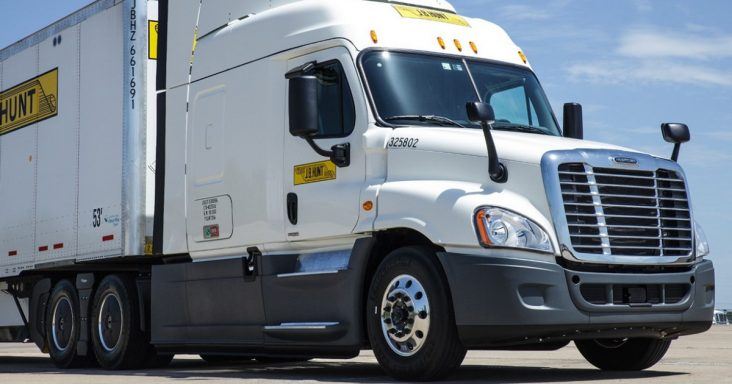J.B. Hunt earnings up 15%, misses estimate on earnings, beats on revenue
by April 16, 2018 11:20 am 463 views

J.B. Hunt Transport Services said increases in freight volume, customer rates and contracts and spot market pricing in the first quarter were partially offset by declined use in the intermodal network, productivity impacts related to winter weather and rising driver pay.
Before the markets opened Monday (April 16), the Lowell-based carrier reported net income for the period that ended March 31 rose 15% to $118.142 million, or $1.07 per share, from $102.702 million, or 92 cents per share. Revenue rose 19.6% to $1.948 billion.
J.B. Hunt missed earnings estimates by 1 cent, based on a consensus of 20 analysts. But it beat revenue estimates by $58 million, based on a consensus of 14 analysts. As of midmorning Monday, shares of J.B. Hunt (NASDAQ: JBHT) were trading at $120.69, up $7.92 or 7.02%. In the past 52 weeks, the stock has ranged between $126.49 and $83.35.
In the first quarter of 2018, capital expenses rose 96.7% to $179.045 million, and the effective tax rate declined 200 basis points to 26% as a result of the recent tax reform. The previous rate is expected to be the annual rate for 2018. Also in the first quarter, the carrier’s net interest expenses rose 34% as a result of an increase in the interest rate on debt. Debt increased 14.6% to $1 billion, from the same period in 2017.
The carrier’s operating income, or earnings before interest and taxes, increased 13% to $168.781 million. Other costs that impacted J.B. Hunt’s earnings included increased purchased transportation costs, higher facilities costs for Final Mile Services, higher maintenance costs on equipment that is set to be traded in 2018, increased spending on technology to upgrade systems, branch expansions and rising equipment ownership, insurance and claims costs.
INTERMODAL
Operating income rose 19.9% to $114.242 million, or 68% of the company’s operating income. The increase in volume growth, customer rate increases and freight mix was partially offset by reduced use and efficiency from third-party drayage as a result of rail congestion, a tight third-party drayage market and increased costs to install and integrate tracking technology for trailers and containers. Drayage refers to the trucks that transport intermodal containers and trailers to and from railroads.
Revenue increased 14.2% to $1.070 billion, or 55% of the carrier’s revenue, as a result of load growth and an increase in revenue per load.
Loads increased 6.2% to 495,764, and revenue per load rose 7.6% to $2,159. Transcontinental loads rose 2%, and Eastern network loads increased 12%. At the end of the period, the number of trucks increased 5.3% to 5,445, and the number of containers and trailers rose 5% to 89,493.
DEDICATED CONTRACT SERVICES
Operating income fell 9.4% to $40.562 million, or 24% of total operating income, and the decline was related to winter weather impacts, increased insurance and claims costs, higher driver pay and recruiting costs, increased non-driver salaries and benefits and a rise of $1.9 million in non-cash amortization expenses.
Revenue rose 26% to $494.480 million, or 25% of total revenue, as a result of the company adding customers and customer rate increases. This was offset by lower productivity and loads per week in the Midwest and Northeast areas impacted by winter weather. Also included in the revenue, Final Mile Service revenue rose 75% or by $35 million, from the same period in 2017.
Loads increased 15.4% to 688,350, and revenue per truck per week increased 5.3% to $4,332. At the end of the period, the number of trucks increased 17.5% to 8,911, and the number of trailers rose 15.5% to 26,514.
INTEGRATED CAPACITY SOLUTIONS
In the carrier’s brokerage segment, operating income rose 98.6% to $8.876 million, or 5% of total operating income. This rise was a result of increased revenue per load, higher gross profit margin and a greater number of branches more than two years old. But the increase was offset by rising employee costs and technology expenses for the continued rollout of the J.B. Hunt 360 transportation management system.
Gross profit margin increased 10 basis points to 14.4% as a result of growth in spot market volume. At the end of the period, the number employees increased 13.8% to 971, the number of third-party carriers in the segment rose 14.8% to 59,800, and the number of branches increased by two to 44 locations.
Revenue increased 41.4% to $296.105 million, or 15% of total revenue. Almost one-third of the revenue, or about $96 million, can be attributed to the marketplace for J.B. Hunt 360. In April 2017, the carrier announced Marketplace, an e-commerce platform and component of J.B. Hunt 360, to better match carriers with shippers by using data and artificial intelligence.
In the first quarter of 2018, loads rose 5.7% to 251,521, revenue per load increased 33.8% to $1,177 as a result of pricing in the spot market. Spot market volume increased 43%, while contract volume fell 7%. Contract business represented 67% of total load volume and 44% of total revenue in the first quarter of 2018, compared to 76% of total loads and 63% of total revenue in the same period in 2017.
TRUCKING
Operating income rose 3.8% to $5.130 million, or 3% of total operating income, as revenue per load increased. Revenue fell 1% to $92.718 million, or 5% of total revenue, as a result of fewer trucks in use.
Loads declined 14.8% to 81,499, and revenue per tractor per week increased 10.7% to $3,775. At the end of the period, the number of tractors fell 10.2% to 1,926, and the number of trailers declined 6.4% to 7,036.
